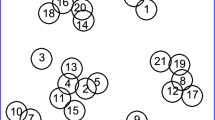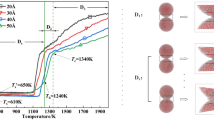Abstract
This study presents the validity and ability of an aggregate mean free path cluster–cluster aggregation (AMP-CCA) model, which is a direct Monte Carlo simulation, to predict the aggregate morphology with diameters form about 15–200 nm by comparing the particle size distributions (PSDs) with the results of the previous stochastic approach. The PSDs calculated by the AMP-CCA model with the calculated aggregate as a coalesced spherical particle are in reasonable agreement with the results of the previous stochastic model regardless of the initial number concentration of particles. The shape analysis using two methods, perimeter fractal dimension and the shape categories, has demonstrated that the aggregate structures become complex with increasing the initial number concentration of particles. The AMP-CCA model provides a useful tool to calculate the aggregate morphology and PSD with reasonable accuracy.










Similar content being viewed by others
References
Abid AD, Heinz N, Tolmachoff ED, Phares DJ, Campbell CS, Wang H (2008) On evolution of particle size distribution functions of incipient soot in premixed ethylene–oxygen–argon flames. Combust Flame 154:775–788. doi:10.1016/j.combustflame.2008.06.009
Abid AD, Camacho J, Sheen DA, Wang H (2009) Quantitative measurement of soot particle size distribution in premixed flames—the burner-stabilized stagnation flame approach. Combust Flame 156:1862–1870. doi:10.1016/j.combustflame.2009.05.01
Artelt C, Schmid HJ, Peukert W (2003) On the relevance of accounting for the evolution of the fractal dimension in aerosol process simulations. J Aerosol Sci 34:511–534. doi:10.1016/S0021-8502(03)00005-3
Balthasar M, Frenklach M (2005a) Detailed kinetic modeling of soot aggregate formation in laminar premixed flames. Combust Flame 140:130–145
Balthasar M, Frenklach M (2005b) Monte-Carlo simulation of soot particle coagulation and aggregation: the effect of a realistic size distribution. Proc Combust Inst 30:1467–1475
Balthasar M, Mauss F, Knobel A, Kraft M (2002) Detailed modeling of soot formation in a partially stirred plug flow reactor. Combust Flame 128:395–409. doi:10.1016/S0010-2180(01)00344-3
Bhatt JS, Lindstedt RP (2009) Analysis of the impact of agglomeration and surface chemistry models on soot formation and oxidation. Proc Combust Inst 32:713–720. doi:10.1016/j.proci.2008.06.201
Blacha T, Di Domenico M, Gerlinger P, Aigner M (2012) Soot predictions in premixed and non-premixed laminar flames using a sectional approach for PAHs and soot. Combust Flame 159:181–193. doi:10.1016/j.combustflame.2011.07.006
Celnik M, Raj A, West R, Patterson R, Kraft M (2008) Aromatic site description of soot particles. Combust Flame 155:161–180. doi:10.1016/j.combustflame.2008.04.011
Celnik MS, Sander M, Raj A, West RH, Kraft M (2009) Modelling soot formation in a premixed flame using an aromatic-site soot model and an improved oxidation rate. Proc Combust Inst 32:639–646. doi:10.1016/j.proci.2008.06.062
Chen D, Zainuddin Z, Yapp E, Akroyd J, Mosbach S, Kraft M (2013) A fully coupled simulation of PAH and soot growth with a population balance model. Proc Combust Inst 34:1827–1835. doi:10.1016/j.proci.2012.06.089
D’Anna A, Kent JH (2008) A model of particulate and species formation applied to laminar, nonpremixed flames for three aliphatic-hydrocarbon fuels. Combust Flame 152:573–587. doi:10.1016/j.combustflame.2007.08.003
Dworkin SB, Zhang Q, Thomson MJ, Slavinskaya NA, Riedel U (2011) Application of an enhanced PAH growth model to soot formation in a laminar coflow ethylene/air diffusion flame. Combust Flame 158:1682–1695. doi:10.1016/j.combustflame.2011.01.013
Hayashi S, Hisaeda Y, Asakuma Y, Aoki H, Miura T, Yano H, Sawa Y (1999) Simulation of soot aggregates formed by benzene pyrolysis. Combust Flame 117:851–860. doi:10.1016/S0010-2180(98)00124-2
Herd CR, McDonald GC, Hess WM (1992) Morphology of carbon-black aggregates: fractal versus euclidean geometry. Rubber Chem Technol 65:107–129. doi:10.5254/1.3538594
Herd CR, McDonald GC, Smith RE, Hess WM (1993) The use of skeletonization for the shape classification of carbon-black aggregates. Rubber Chem Technol 66:491–509. doi:10.5254/1.3538323
Imre AR (2006) Artificial fractal dimension obtained by using perimeter–area relationship on digitalized images. Appl Math Comput 173:443–449. doi:10.1016/j.amc.2005.04.042
Ivie JJ, Forney LJ (1988) A numerical model of the synthesis of carbon black by benzene pyrolysis. AIChE J 34:1813–1820. doi:10.1002/aic.690341107
Iyer SS, Litzinger TA, Lee S-Y, Santoro RJ (2007) Determination of soot scattering coefficient from extinction and three-angle scattering in a laminar diffusion flame. Combust Flame 149:206–216. doi:10.1016/j.combustflame.2006.11.009
Kumar S, Ramkrishna D (1996) On the solution of population balance equations by discretization—I. A fixed pivot technique. Chem Eng Sci 51:1311–1332. doi:10.1016/0009-2509(96)88489-2
Lindstedt RP, Waldheim BBO (2013) Modeling of soot particle size distributions in premixed stagnation flow flames. Proc Combust Inst 34:1861–1868. doi:10.1016/j.proci.2012.05.047
Manzello SL, Lenhert DB, Yozgatligil A, Donovan MT, Mulholland GW, Zachariah MR, Tsang W (2007) Soot particle size distributions in a well-stirred reactor/plug flow reactor. Proc Combust Inst 31:675–683. doi:10.1016/j.proci.2006.07.013
Mitchell P, Frenklach M (1998) Monte Carlo simulation of soot aggregation with simultaneous surface growth—why primary particles appear spherical. Symp (Int) Combust 27:1507–1514
Mitchell P, Frenklach M (2003) Particle aggregation with simultaneous surface growth. Phys Rev E 67:061407
Morgan N, Kraft M, Balthasar M, Wong D, Frenklach M, Mitchell P (2007) Numerical simulations of soot aggregation in premixed laminar flames. Proc Combust Inst 31:693–700
Mulholland GW, Samson RJ, Mountain RD, Ernst MH (1988) Cluster size distribution for free molecular agglomeration. Energy Fuels 2:481–486. doi:10.1021/ef00010a014
Nakaso K, Shimada M, Okuyama K, Deppert K (2002) Evaluation of the change in the morphology of gold nanoparticles during sintering. J Aerosol Sci 33:1061–1074. doi:10.1016/S0021-8502(02)00058-7
Ono K, Yanaka M, Tanaka S, Saito Y, Aoki H, Fukuda O, Aoki T, Yamaguchi T (2012) Influence of furnace temperature and residence time on configurations of carbon black. Chem Eng J 200–202:541–548. doi:10.1016/j.cej.2012.06.061
Ono K, Yanaka M, Saito Y, Aoki H, Fukuda O, Aoki T, Yamaguchi T (2013) Effect of benzene–acetylene compositions on carbon black configurations produced by benzene pyrolysis. Chem Eng J 215–216:128–135. doi:10.1016/j.cej.2012.10.085
Ono K, Watanabe A, Dewa K, Matsukawa Y, Saito Y, Matsushita Y, Aoki H, Fukuda O, Aoki T, Yamaguchi T (2014a) Detailed kinetic analysis of the effect of benzene–acetylene composition on the configuration of carbon nanoparticles. Chem Eng J 250:66–75. doi:10.1016/j.cej.2014.03.091
Ono K, Watanabe A, Dewa K, Matsukawa Y, Saito Y, Matsushita Y, Aoki H, Fukuda O, Aoki T, Yamaguchi T (2014b) Detailed kinetic analysis of the impact of nucleation behavior and particle size distribution on the configurations of carbon black. J Nanopart Res 16:1–11. doi:10.1007/s11051-014-2519-7
Park SH, Rogak SN (2004) A novel fixed-sectional model for the formation and growth of aerosol agglomerates. J Aerosol Sci 35:1385–1404. doi:10.1016/j.jaerosci.2004.05.010
Sander M, Patterson RIA, Braumann A, Raj A, Kraft M (2011) Developing the PAH-PP soot particle model using process informatics and uncertainty propagation. Proc Combust Inst 33:675–683. doi:10.1016/j.proci.2010.06.156
Seto T, Hirota A, Fujimoto T, Shimada M, Okuyama K (1997) Sintering of polydisperse nanometer-sized agglomerates. Aerosol Sci Technol 27:422–438. doi:10.1080/02786829708965482
Shishido F, Hashiguchi H, Matsushita Y, Morozumi Y, Aoki H, Miura T (2007) An investigation of primary particle growth and aggregate formation of soot using a numerical model considering the sintering of primary particles. Kagaku Kogaku Ronbunshu 33:306–314. doi:10.1252/kakoronbunshu.33.306
Stöber W (1976) In: Liu BYH (ed) Fine particles. Academic Press, New York, p 354
Wang H (2011) Formation of nascent soot and other condensed-phase materials in flames. Proc Combust Inst 33:41–67. doi:10.1016/j.proci.2010.09.009
Watanabe R, Shindoh T, Matsushita Y, Aoki H, Miura T, Nishiwaki K, Yamada H, Fukuda O, Yamaguchi T (2010) A numerical investigation of the factors influencing the aggregate shape of carbon black from the furnace process. J Chem Eng Jpn 43:150–157. doi:10.1252/jcej.09we170
Xiong Y, Pratsinis SE (1993) Formation of agglomerate particles by coagulation and sintering—Part I. A two-dimensional solution of the population balance equation. J Aerosol Sci 24:283–300
Zhang Q, Guo H, Liu F, Smallwood GJ, Thomson MJ (2009a) Modeling of soot aggregate formation and size distribution in a laminar ethylene/air coflow diffusion flame with detailed PAH chemistry and an advanced sectional aerosol dynamics model. Proc Combust Inst 32:761–768. doi:10.1016/j.proci.2008.06.109
Zhang Q, Thomson MJ, Guo H, Liu F, Smallwood GJ (2009b) A numerical study of soot aggregate formation in a laminar coflow diffusion flame. Combust Flame 156:697–705. doi:10.1016/j.combustflame.2008.10.022
Author information
Authors and Affiliations
Corresponding author
Rights and permissions
About this article
Cite this article
Ono, K., Matsukawa, Y., Saito, Y. et al. Monte Carlo simulation for morphology of nanoparticles and particle size distributions: comparison of the cluster–cluster aggregation model with the sectional method. J Nanopart Res 17, 242 (2015). https://doi.org/10.1007/s11051-015-3049-7
Received:
Accepted:
Published:
DOI: https://doi.org/10.1007/s11051-015-3049-7




